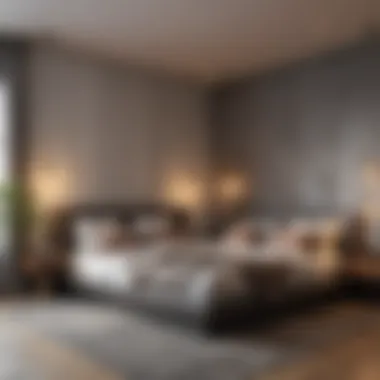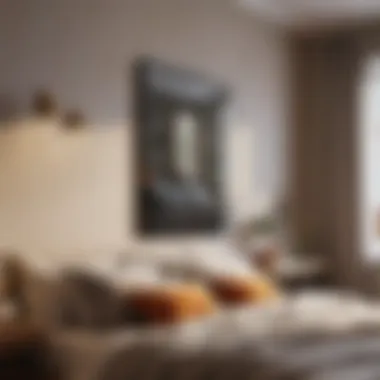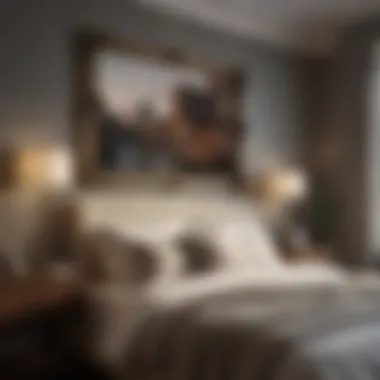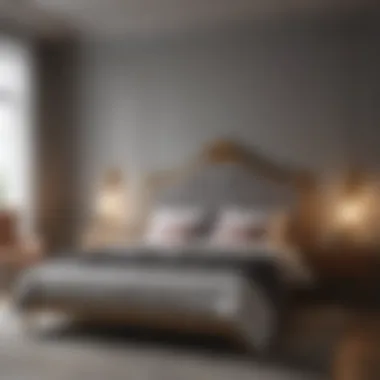Crafting a Bedroom Design App: Key Insights


Intro
In the rapidly evolving world of technology, designing a bedroom app to personalize spaces is not just a luxury, but a necessity for many homeowners. This guide aims to delve into the various aspects of creating a bedroom design application that marries aesthetics with functionality. By focusing on user needs, you can transform how individuals interact with their personal spaces. Whether it’s streamlining layout designs or incorporating the latest technology, the insights provided here aim to offer a comprehensive overview for aspiring developers and keen homeowners alike.
Design Inspirations
Creating a bedroom that resonates with its inhabitants begins with sound design principles. Pulling inspiration from both modern and traditional styles can offer diverse options to cater to a wider audience, allowing users to create spaces where they feel truly at home.
Modern vs. Traditional Bedroom Styles
When discussing bedroom design, it's essential to understand the dichotomy between modern and traditional styles.
- Modern styles lean towards minimalism with clean lines, neutral colors, and functional furniture. This is ideal for individuals who appreciate a contemporary aesthetic—think Scandinavian or industrial design.
- Traditional styles, on the other hand, embrace warmth and ornate details. Incorporating rich wood finishes, intricate patterns, and classic furniture can evoke a sense of nostalgia and comfort, appealing to users who prefer a timeless feel.
Understanding these styles helps users identify their preferences, which can be translated into customizable features in the app.
Color Palettes and Textures
Color scheme is another crucial element in bedroom design. Users might want to express themselves through their choices.
- Neutral hues like whites, grays, and beiges can create a calming environment.
- Bold colors such as navy or emerald provide drama and interest.
Textures also play an integral role. Mixing and matching materials—like soft fabrics for pillows and sleek wooden surfaces for furniture—can elevate a bedroom experience.
Ultimately, the blend of color and texture can be integrated within the app, allowing users to visualize their selections dynamically.
"Design is not just what it looks like and feels like. Design is how it works." – Steve Jobs
By tying together these elements, you create a platform that not only assists in planning the design but enriches the overall decision-making process for the user.
Instead of restricting themselves to single themes, users can create their own unique style by utilizing the multitude of options available.
In the next sections, we will discuss how to implement these ideas effectively, considering factors like user engagement strategies and market demands.
Prologue to Bedroom Design Applications
In the fast-paced world of home improvement and personal expression, bedroom design applications have emerged as invaluable tools, enabling users to craft their ideal sanctuaries with ease and creativity. This section delves into the significance of these applications, guiding both developers and users in understanding how they can revolutionize personal spaces.
Overview of Bedroom Design Trends
Today, the landscape of bedroom design is constantly changing, reflecting an array of tastes, lifestyles, and technological advancements. Pastel colors and minimalist themes are giving way to more eclectic styles, where personal flair is at the forefront. Homeowners are now seeking ways to express their identities through their bedroom decor, moving beyond merely functional design. With the rise of smart home concepts, features incorporating technology into aesthetics are becoming increasingly prevalent.
- Eclectic Styles: Mixing different design elements, such as vintage finds with modern flair, creates unique atmospheres.
- Smart Features: Automation and smart devices, like smart bulbs or thermostats, not only enhance functionality but also bring innovative design solutions to life.
- Sustainable Materials: More consumers are gravitating toward eco-friendly materials, emphasizing sustainability in their design choices.
These trends underscore the necessity for developers to stay ahead of the curve and integrate modern aesthetics and functionality into their bedroom design applications.
Importance of Personal Space Design
Designing one's personal space holds greater weight than mere aesthetics; it significantly impacts an individual’s well-being and productivity. A thoughtfully arranged bedroom can serve as a retreat from the chaos of daily life, fostering relaxation and rejuvenation. Consider the following:
- Psychological Benefits: A well-designed bedroom often contributes to better mental health, reducing stress levels and creating a tranquil environment.
- Functional Spaces: Incorporating smart layouts ensures that rooms serve their purpose effectively, from a tiny nook for reading to a spacious area for sleep.
- Reflective of Identity: The bedroom is a canvas for personal expression. Every choice made, from color to furniture, reflects the occupant’s personality and preferences.
"A bedroom isn’t just a place to sleep; it is a sanctuary that nurtures creativity and peace."
Personal space design is essential for fostering comfort and encouraging productivity, making it crucial for developers to provide robust options in bedroom design applications. With this understanding, the subsequent sections will further explore user needs, core features, and the integration of contemporary technologies in bedroom design applications.
Understanding User Needs
Understanding user needs forms the backbone of any successful application, and it's no different when it comes to a bedroom design app. Knowing what potential users are seeking in an app is vitally important. It not only aids in refining the app's features but also ensures it resonates well with its intended audience. Without a solid grasp of these needs, developers risk creating something that may look good on paper but fails spectacularly in practice.
There are several specific elements to consider in this process. First, it's about identifying key issues users face in bedroom design. To some, it might be simply about visualizing spaces before committing to purchases or layout changes, while others might require deeper customization options to express their unique style in their personal sanctuaries. Understanding these problems allows for targeted feature development that addresses user pain points directly, making the app more relevant and useful.
An additional benefit to prioritizing user needs is that it inherently fosters user engagement and loyalty. If individuals find an app responsive to their specific needs, it encourages them to stick around longer. They are more likely to return for updates or new features if they believe their input has been considered. Additionally, users appreciate personalized approaches, which can turn a standard tool into something they feel connected to—an aspect that is often overlooked.
Finally, when you align the app’s functions with user requirements, it paves the way for measurable outcomes. This means implementing areas such as feedback loops to continually adjust and enhance the user experience. Regularly evaluating what’s working and what’s not can lead to a more polished product over time.
"Empathy is the greatest form of intelligence in design. Knowing your audience can transform a decent app into an essential one."
By establishing a framework that prioritizes the understanding of user needs from the very beginning, you are more likely to see your bedroom design app not as just another product but as a valuable tool that can genuinely elevate a person’s living environment.


Current Market Needs
Delving into the current market landscape reveals several crucial needs tied to bedroom design. One of the prevalent trends is the surge in remote working and the consequent need for multi-functional spaces. Homeowners now seek layouts that accommodate both work and relaxation. Incorporating features that allow users to design adaptable spaces that meet these dual needs can be a significant selling point.
Moreover, many consumers today desire sustainable design options. This ranges from using eco-friendly materials to energy-efficient appliances. An application that emphasizes these elements will not only appeal to environmentally conscious buyers but may also give a competitive edge in a crowded market.
Additionally, there is a notable demand for enhanced functionality through technology integration. Users seek apps offering automated solutions, from lighting to temperature controls. Addressing this market need means creating an interconnected experience, enhancing the overall comfort of their bedroom.
Identifying User Preferences
Identifying what users prefer in a bedroom design app often involves a mix of surveys, market analysis, and direct engagement. Preferences vary widely depending on individual tastes, lifestyles, and even demographics. It can be beneficial to segment users into categories based on these factors to hone in on specific desires.
For instance, younger users might gravitate towards trendy color schemes or modular furniture arrangements, while older users might prioritize functionality and ease, seeking to minimize clutter without sacrificing aesthetics. Understanding these differences assists in creating highly customized experiences that resonate on a personal level.
In a digital age where consumers are bombarded with choices, offering personalized features can significantly influence user satisfaction. Providing options for various design styles—from minimalist to maximalist—echoes the diversity in user preferences.
It might be useful to develop exploratory tools within the app that allow users to experiment with different styles and preferences. This way, users can see their choices in action, making them more likely to interact with the app regularly. By creating a platform that both caters to individual tastes and simplifies the decision-making process, you help users feel more invested in their design journeys.
Core Features of the Application
Creating a successful bedroom design app hinges upon a few fundamental components that shape the user experience. These core features not only set the foundation for utility but also encourage creativity and satisfaction among users. A well-designed application needs to be intuitive, engaging, and personalized, ensuring it meets the specific needs of homeowners and homemakers alike. Understanding these key elements will drive the development process and guide what features to prioritize.
User Interface and Experience Design
User interface (UI) and user experience (UX) design play pivotal roles in how users interact with the app. A clean and simple interface allows users to navigate through options without feeling overwhelmed. In this context, the design should feel like a warm invitation rather than a confusing maze. Key considerations might include:
- Simplicity: The layout should be straightforward, ensuring that users can easily find tools and options they need without excessive clicking.
- Aesthetic Appeal: Using colors and graphics that resonate with home aesthetics can enhance engagement. Soft colors and minimalist icons could be particularly effective.
- Responsiveness: Given the variety of devices used by users, the app should adapt seamlessly to different screen sizes. A responsive design doesn’t only improve visual appeal but also functionality across devices.
For an exceptional user experience, incorporating feedback mechanisms is crucial. Users should be able to easily report issues, which can inform future updates. It’s also beneficial to offer tutorials or guided walks for new users to steer them through the primary functions of the app.
3D Visualization Capabilities
In today’s digital age, seeing a design come to life with just a few clicks could be the make or break for many users. 3D visualization allows users to step into their designs through lifelike representations. This feature provides several advantages:
- Enhanced Understanding: Users can comprehend spatial relationships better through 3D visualizations. This ability helps in making informed design decisions, such as understanding how furniture choices fit together in a physical space.
- Realism: Offering realistic renderings of textures and colors can dramatically elevate the design experience. Users can see whether that emerald green bedding clashes with the oak floor before making any purchases or commitments.
- Experimentation: A robust 3D visualization tool encourages users to play around with their designs and explore various options without the fear of irreversible commitment.
If users can visualize their intended spaces clearly, they are more likely to embrace the design process and make confident choices. Thus, investing in high-quality 3D options can be a significant differentiator in a crowded market.
Inventory Management for Design Elements
An inventory management system can provide users with an organized way to keep track of items they wish to incorporate into their spaces. Here, the core feature focuses on easy access to design elements through effective categorization and availability tracking. Consider these aspects for effective inventory management:
- Categorization: Users should be able to sort items by categories such as furniture, lighting, and décor. This way, finding something specific becomes a breeze and promotes efficiency.
- Stock Availability: Connecting the app with real-time inventory systems can alert users whether a particular item is in stock before they start designing around it. No one wants to find the perfect couch only to discover it’s sold out for months.
- Integration with Retailers: Partnering with retailers could also streamline the user experience by enabling direct buy options within the app, fostering a seamless transition from idea to purchase.
By offering this feature, you're not just enhancing user experience but also providing the necessary tools for efficient project management that homeowners desire.
"The key to a successful design app lies in its usability and the depth of personalization it offers the user."
Overall, by prioritizing UI/UX, 3D visualization, and effective inventory management, your bedroom design app can appeal strongly to its users and may very well transform how people approach their personal spaces.
Customization Options
In the realm of bedroom design applications, customization options stand out like stars in a clear night sky. They offer users a chance to mold their personal sanctuaries to reflect their unique tastes and styles. It’s not just about choosing colors or arranging furniture; it’s about creating a space that resonates with one's identity. Here, we shall peel back the layers of this critical aspect of app design, focusing on elements such as color schemes, layout arrangements, and personalized decor choices that cater specifically to housewives and homeowners.
Color Schemes and Themes
Choosing the right color scheme can be as pivotal as selecting the perfect paintbrush for a masterpiece. Colors have a profound effect on mood and atmosphere in any space, especially in bedrooms where comfort is paramount. A well-designed app should empower users to experiment with various palates, from soft pastels to bold, energetic hues.
- Mood Setting: Colors can evoke emotions. For example, soft blues can instill tranquility, while vibrant reds may energize the room. Users should be able to visualize how these colors pair with selected themes, allowing them to craft an environment that speaks to their lifestyle.
- Theme Harmony: Beyond individual colors, themes like minimalist, bohemian, or modern industrial can guide users in their choices. An app that allows seamless integration of color schemes into these themes will help users minimize the guesswork.
- Testing Flexibility: Before committing to a color, it is beneficial to offer features that let users see their chosen colors on virtual walls. Something like a color wheel or palette generator could help them make more informed decisions.
As the saying goes, "life is too short to live in boring spaces"; empowering users to explore color schemes aligns perfectly with crafting vibrant and engaging environments.
Layout and Furniture Arrangement
The layout and furniture arrangement of a bedroom can often mean the difference between a peaceful retreat and a chaotic mess. An ideal design application should guide users in optimizing their space, ensuring that every inch counts.
- Space Utilization: Users often underestimate the importance of flow in a room. Understanding how furniture placement affects daily routines could significantly enhance functionality.
- Guided Visualization: Features like drag-and-drop functionality to place virtual furniture allow users to visualize arrangements before making physical changes. This flexibility can save both time and resources, allowing users to try out arrangements.
- Room Dimensions: Including tools for measuring room dimensions directly within the app can aid users in making precise choices about furniture size and layout.
By focusing on these elements, the application can assist users in creating layouts that not only look great but also function well for their everyday activities.


Personalized Decor Choices
The small touches in a bedroom often reflect who a person truly is. Personalized decor choices contribute immeasurably to a room’s character and warmth. An effective app should facilitate this process, made easier through several thoughtful features.
- Catalog of Options: Provide a comprehensive library of decor items like wall art, throw pillows, or area rugs. This should include various styles and price points, tailored to users' preferences, ensuring everyone finds something appealing.
- User-Generated Content: Encourage users to share their decor choices, allowing the community to inspire each other. Real-life examples can provide valuable perspectives and open new avenues of creativity.
- Customization Tools: Users should be able to modify items; for instance, changing the fabric of a sofa or the finish on a side table. Empowering users to create their individual style makes the application invaluable.
"Your home should tell the story of who you are, and be a collection of what you love."
By weaving together these customization options within the bedroom design app, developers can create a platform that resonates deeply with users, fostering a sense of ownership and pride in their living spaces.
Integration of Technology
The intersection of technology and bedroom design apps is an exciting frontier that has redefined how personal spaces are conceived and nurtured. Integrating advanced technology not only enriches the overall user experience but also personalizes the design journey to mirror individual needs and preferences. Users today seek to blend functionality with aesthetics, making it imperative for developers to adopt a tech-savvy approach. Smart features and immersive experiences can bridge the gap between imagination and reality, which ultimately makes spaces more livable and enjoyable.
Smart Home Features
Smart home technology represents a significant leap forward in how we interact with our living environments. Features such as automated lighting, climate control, and integrated security systems create an interconnected ecosystem right in the bedroom.
Consider the impact of smart lighting. Imagine adjusting the brightness and color of your bedroom lights with just a few taps on your phone, or calming down for the night as the lights automatically dim to a soft glow. This adaptability not only enhances the aesthetic of your space but also contributes to the circadian rhythm by promoting better sleep habits.
Moreover, linking the bedroom app with platforms like Amazon Alexa or Google Home can elevate user convenience. Homeowners can control their settings verbally, which makes for a seamless integration into daily routines.
Here are some essential smart home features to include:
- Automated temperature settings: Adjusts heating or cooling based on user preferences and time of day.
- Smart curtains: These control sunlight levels and improve energy efficiency.
- Home security systems: Users can monitor their space at any time, ensuring peace of mind.
By adopting smart technology, the bedroom becomes not just a place to sleep but a versatile environment that caters to varying needs throughout the day.
Augmented Reality Experiences
Augmented Reality (AR) has transformed many industries, and interior design is no exception. Integrating AR into a bedroom design app allows users to visualize changes before they commit to a purchase. This is powerful since the perception of space can shift dramatically depending on furniture placement or décor choices.
Imagine being able to see exactly how that intricately designed velvet sofa would fit into your corner nook before even buying it. With AR, users can simply point their smartphone camera at their room and overlay virtual furniture onto real-life scenarios. This not only saves time and money but also enhances decision-making by providing a richer, more informed visual experience.
Key Benefits of AR Integration:
- Enhanced visualization: Experience how various styles and colors fit into the existing space.
- Interactive engagement: Users can manipulate design elements, making the process more engaging.
- Proof before purchase: Avoid the uncertainty of buying items that might not fit—literally and figuratively.
The incorporation of AR in a bedroom design app can be a game changer for designers and homeowners alike.
In today’s digital age, blending practical technology with esthetics creates an inviting and efficient living space where every detail matters.
In summary, integrating technology into bedroom design applications is not just an add-on; it's essential. From smart home features that create a responsive environment to augmented reality tools that allow users to realize their vision, this tech-savvy approach fosters creativity and personalization. As users explore their options, the boundaries of modern living are continuously reshaped.
Market Analysis
In the realm of bedroom design applications, a thorough market analysis stands as a cornerstone for developing a successful product. Understanding the landscape in which your app will operate provides crucial insights into user behaviors, preferences, and competitive advantages. This not only helps in defining your app’s unique selling points but also plays a pivotal role in guiding product features that resonate with potential customers.
Competitor Evaluation
When we talk about competitor evaluation, it goes beyond just knowing who else is in the ring. It’s about taking a hard look at their strengths, weaknesses, and market positioning. By analyzing established players like Houzz and MagicPlan, you get a window into what works and what doesn’t.
- Feature Comparison
- Pricing Strategies
- Target Audience
- Determine what functionalities competitors offer. Do they have augmented reality capabilities? Are their user interfaces smooth and intuitive?
- Look into user reviews and feedback to identify common pain points. This information can be dynamics for your improvements.
- Explore their pricing models: Are they subscription-based, freemium, or one-time purchases? Understanding their pricing will help you position your product more effectively.
- Take note of promotional strategies they use—casual discounts, seasonal offers, or strategic partnerships can enhance visibility.
- Everyone caters to someone. Identify the demographics that your competitors are targeting and see if there’s an underserved market segment you can tap into.
By conducting a thorough evaluation, you not only grasp the competitive landscape but also carve a niche for your own application, tailored to meet overlooked user needs.
Target Demographics
Understanding the target demographics is another fundamental piece in the puzzle of market analysis. It’s essential to identify not just who your users are, but what they value in a bedroom design app. Studies show that housewives and home owners are often keen on creating personal spaces that reflect their tastes while being functional.
- Age Group
- Socioeconomic Status
- Lifestyle Choices
- Different age groups have varied expectations. Younger homeowners might lean towards modern aesthetics, while older users could appreciate a more classic look.


- This affects influence on preferences. Higher income users likely prioritize design quality, while a more budget-conscious audience may appreciate value features like smart saving suggestions.
- Analyzing lifestyle factors such as minimalism, family dynamics, or eco-conscious choices can further clarify your audience’s desires. For instance, families with children might favor functionality over flamboyance.
By digging deep into the demographics, developers can avoid launching a one-size-fits-all app. Instead, it allows for more strategic decisions, ensuring features align closely with user desires, ultimately leading to a product that not only attracts downloads but also fosters long term engagement.
"Understanding who your users are can be the difference between a fleeting download and a loyal customer."
Take the time to explore these aspects thoroughly. Only then can your application begin to resonate, turning potential users into devoted fans.
User Engagement Strategies
In the saturated world of app development, user engagement stands as a pillar of success for any application, particularly one focused on designing personal spaces like bedrooms. Engaging users is not just about getting them to download your app; it's about fostering a community and creating a personalized experience that compels users to return time and again.
Feedback and Improvement Cycles
A critical component of user engagement is the establishment of feedback and improvement cycles. This involves collecting, analyzing, and implementing user feedback to refine the app's features and functionality. Simple methods like in-app surveys, feedback forms, or even direct prompts after a user has engaged in a design session can yield insightful data. For instance, after a user arranges their bedroom layout virtually, a prompt could ask how satisfied they were with the process or what they felt was missing.
Regularly updating the app based on user feedback fosters a sense of collaboration between the developers and the users. It shows that you value their opinions and are committed to enhancing their experience. Additionally, integrating this feedback into functional updates can enhance user retention. By addressing their concerns, you not only improve the app but also build trust and loyalty.
Community Building within the App
Creating a sense of community within the app can significantly increase user engagement. Encouraging users to share their designs or decorating tips fosters an interactive environment where users feel they belong. Think about integrating a platform for users to post pictures of their newly designed bedrooms or ask for advice. This can be as simple as a gallery section where users can interact with each other.
Moreover, implementing social features such as comment sections or forums for discussions will also promote exchange of ideas and inspire creativity. Users can connect over shared interests and even collaborate on projects.
A strong community encourages word-of-mouth promotion. Users are likely to share their experiences on social media, inviting friends and family to join the application journey. It’s beneficial to consider influencer partnerships on platforms like Facebook or Reddit to broaden your reach. Leveraging these communities not only drives app downloads but also positions your application as a leader within bedroom design app spaces.
"A well-engaged user community can define the success of an application. It’s about more than just features; it’s about creating ties that hold the user base together."
Creating an app where users feel invested, heard, and valued is essential. By focusing on feedback and community, you are paving the way for a vibrant user engagement strategy.
Future Trends in Bedroom Design Applications
As we delve into the future of bedroom design applications, it’s crucial to appreciate how these trends can shape personal spaces in ways we may not have imagined yet. The evolution of interior design has historically mirrored cultural shifts, technological advancements, and an increasing focus on sustainability. By understanding these emerging trends, developers can create applications that not only meet current user needs but also anticipate what the future holds.
Sustainable Design Elements
Sustainability isn't just a buzzword; it's fast becoming a fundamental aspect of modern living. Integrating sustainable design elements into bedroom applications can profoundly impact how users interact with their spaces. Here are several key considerations:
- Eco-friendly materials: Users increasingly favor designs that utilize sustainable materials. Offer options that include bamboo, recycled metals, and organic textiles. These choices not only appeal to environmentally-conscious consumers but also add a unique aesthetic to designs.
- Energy efficiency: Features highlighting energy-saving devices and appliances can be pivotal. This could range from smart window treatments that adjust based on sunlight levels to LED lighting that optimizes consumption.
- Biophilic design: Incorporating nature into interiors is growing in popularity. Facilitate virtual plants or natural light simulation features within the app, allowing users to create a more inviting and restorative environment that mimics the outdoors.
"Design is a plan for arranging elements in such a way as to best accomplish a particular purpose." – Charles Eames
By structurally embedding sustainable choices into the application, users experience a deepened connection to their living space and the environment. Encouraging environmentally sustainable decisions can increase user satisfaction, while also fostering a sense of responsibility towards the planet.
Emerging Technologies and Their Impact
Technology evolves at lightning speed, and so do its applications in interior design. Understanding these technologies can provide critical advantages for designers. Here are some notable trends to keep an eye on:
- Artificial Intelligence (AI): AI can personalize user experiences in real-time. By analyzing user preferences, AI can make design suggestions that resonate with individual aesthetics. Imagine an app that learns how a user arranges furniture over time and offers smarter layout suggestions based on that data.
- Augmented Reality (AR): Although already touched upon, AR plays a significant role in transforming how users visualize their rooms. By simply viewing their room through a smartphone or tablet’s camera, users can see how different layouts or colors will look in real-time, bridging the gap between imagination and reality.
- Smart Home Integration: The rise of the Internet of Things (IoT) means that incorporating smart tech in bedroom apps is not just an option anymore – it's a necessity. Users want to control lighting, climate, and entertainment systems from one cohesive app, enhancing convenience and comfort in their personal spaces.
The continual advance of these technologies creates immense opportunity for apps to provide seamless user experiences that empower homeowners to create their sanctuaries. As these innovations take root, they can transform bedrooms into highly personalized and functional living areas.
Culmination and Call to Action
As we wrap up our extensive examination of designing a bedroom application, it becomes clear that the path ahead is filled with opportunities to transform how individuals interact with their personal spaces. The convergence of technology and design principles lays a solid foundation for creating a more personalized and fulfilling user experience. With a mindful approach to features, customization, and user engagement, the application can serve as a valuable tool that helps users curate their intimate environments. This isn’t just about design; it’s about fostering well-being through tailored solutions that meet diverse needs.
Summarizing Key Insights
In our exploration, we have pinpointed several crucial aspects of developing a top-notch bedroom design app:
- User-Centric Design: Prioritizing the needs of users ensures the application resonates well with its target audience. Understanding what house owners and housewives seek from such software equips developers to create features that truly matter.
- Customization Flexibility: Allowing users to personalize themes, layouts, and decor is essential. A greater degree of customization leads to satisfied users who feel an emotional connection to their space.
- Technology Integration: Embracing smart home technology and augmented reality can significantly enhance user experience, creating an app that not only meets but exceeds expectations.
- Community Building: Engaging users through forums or feedback cycles fosters a sense of belonging and encourages users to share their unique designs, contributing to a vibrant community.
This holistic understanding of the essential features ensures that the application is both functional and emotionally satisfying, ultimately leading to an enriched living space.
Encouragement for Design Exploration
Now, with the knowledge and insights at hand, it’s time for users and developers alike to take action. Whether you’re a house owner keen on redefining your bedroom or a developer ready to bring your app to life, don’t shy away from diving deep into the world of design exploration. Consider the following:
- Experiment with Styles: Nothing is off-limits in the realm of personal design. Trying different styles or layouts can reveal surprisingly pleasing results that align with your personality.
- Engage with Tech Tools: Utilize various design applications currently available as stepping stones to gather ideas or refine your vision.
- Join Design Communities: Leverage platforms like Reddit or Facebook to connect with fellow enthusiasts. Share ideas, seek feedback, and inspire each other.
- Iterate and Evolve: Remember that design is an ongoing process. Regularly revisit your choices as tastes and needs evolve over time.
"Design is not just what it looks like and feels like. Design is how it works." - Steve Jobs
So, embark on this journey. The room you retreat to should not only be a resting place but a haven that reflects who you are. With each choice made, you're one step closer to a beautifully curated space. Let's shape our environments for the better.















